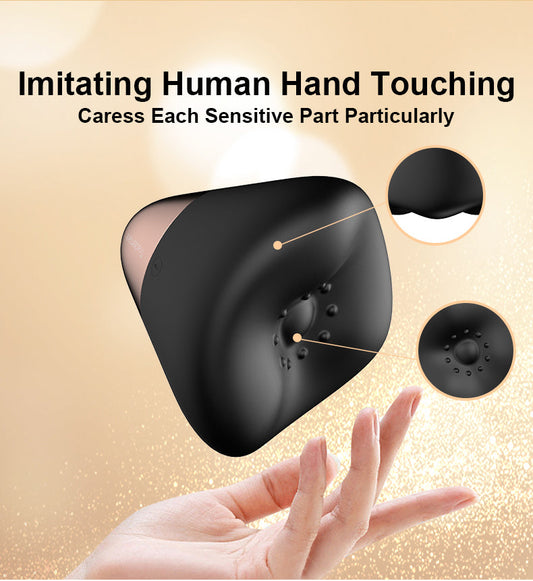
Exploring Simultaneous Orgasms in Real Life
Introduction
The idea of two lovers reaching climax together has captured imaginations for generations. Whether in romantic stories or art, this image often represents a deep sense of intimacy. But behind the appeal is a blend of biology, emotions, and social expectations. Simultaneous orgasm isn’t just about timing, it’s about learning each other’s bodies, communicating openly, and enjoying the journey together.
In this guide, we’ll explore the science, share practical tips, and gently challenge some common myths about orgasm. You’ll find advice on positions, pacing, and how adult toys can help partners get in sync. Most importantly, we’ll talk about how focusing on connection and fun—rather than perfection—can make your intimate moments even more rewarding.
You’ll also learn about the influence of sex positions for orgasm, how the concept of a vaginal orgasm has been debated in science, and what couples really experience when aiming for a mutual orgasm.
Why Simultaneous Orgasm Is So Intriguing
Human sexuality blends biology with imagination. The appeal of climaxing together goes beyond physical pleasure—it represents connection, trust, and mutual enjoyment. It’s a symbolic dance of intimacy where two people feel synchronized not just physically, but emotionally.
However, reality often challenges this fantasy. Timing is rarely perfect, and physiological differences can make simultaneous orgasm elusive. A large U.S. survey of 52,000 adults (Frederick et al., 2018) revealed significant differences in orgasm frequency:
| Group | Usually–Always Orgasm (%) |
|---|---|
| Heterosexual men | 95% |
| Gay men | 89% |
| Bisexual men | 88% |
| Lesbian women | 86% |
| Bisexual women | 66% |
| Heterosexual women | 65% |
This “orgasm gap” highlights why synchronized climaxes are difficult. If one partner consistently reaches orgasm faster than the other, achieving simultaneous peaks becomes a rare event rather than the norm.
Beyond biology, cultural narratives contribute to the fascination. Films, books, and even pornography often depict mutual orgasms as a pinnacle of sexual achievement, reinforcing the perception that perfectly timed pleasure equals relationship success. Understanding this context can relieve unnecessary pressure and allow couples to approach intimacy with curiosity rather than performance anxiety.
Understanding Female Orgasm: Variety, Not Limitation
Historically, the notion of a vaginal orgasm has sparked debate. Early psychoanalysts suggested that clitoral orgasms were “immature,” while vaginal orgasms were “mature,” implying women needed vaginal penetration to experience full sexual satisfaction. Modern science, however, rejects this simplistic binary.
Neuroscientific research using functional MRI has shown that different areas of the brain respond depending on whether stimulation is clitoral, vaginal, or a combination of both (Komisaruk & Whipple, 2011). Some women report intense pleasure from G-spot stimulation; others find clitoral stimulation essential, even during penetrative sex. Some people experience blended orgasms involving multiple erogenous zones simultaneously.
This perspective frames orgasm as a spectrum rather than a checklist. Each pathway is valid, and each can be explored safely and consensually. By understanding this variability, couples can shift focus from chasing a stereotypical “ideal” orgasm to discovering what truly feels best for both partners.
Positions and Pacing: Practical Pathways
People often seek the “best sex positions” to increase the likelihood of orgasm. While no position guarantees simultaneous climaxes, certain positions naturally allow better stimulation and control:
- Cowgirl (woman on top): Offers the woman clitoral control while maintaining penetration.
- Modified Missionary: Placing a pillow under the woman’s hips can optimize angle and contact.
- Spooning: Allows full-body contact, gentle rhythm, and opportunities for external stimulation.
- Edge positions: Combining penetration with hand or toy stimulation can enhance arousal.
What unites these positions is anatomical alignment and the opportunity to coordinate rhythm. Beyond positioning, pacing is critical. Couples who synchronize breathing, verbal cues, and movements create a feedback loop that allows each partner to adjust intensity gradually. Extending arousal rather than rushing toward orgasm increases the probability of overlap.
Communication: The Cornerstone of Shared Pleasure
No amount of technique replaces open communication. Couples who discuss preferences, sensitivities, and desired intensity generally experience higher satisfaction. Communication includes:
- Expressing when stimulation feels good or too intense.
- Sharing fantasies or specific desires to enhance anticipation.
- Checking in during sex to adjust rhythm, angle, or pressure.
Couples often underestimate the power of verbal cues. Even subtle words or sounds can serve as signals that guide pacing and alignment. Sexual communication also builds trust, reduces anxiety, and makes the pursuit of simultaneous orgasm a collaborative, playful journey rather than a competitive challenge.

Techniques to Increase Synchronization
While perfect timing is rare, certain strategies help couples get closer:
- Foreplay Synchronization: Engaging in extended foreplay that excites both partners allows them to approach orgasm simultaneously. Shared touching, kissing, and oral stimulation can prepare the body for mutual climax.
- Delaying Tactics: The partner who reaches orgasm faster can slow down through pauses, changing rhythm, or using techniques like squeezing the base of the penis or adjusting positions.
- Adult Toys: Vibrating rings, dual-stimulation vibrators, and small external vibrators can help align arousal levels. Toys are particularly useful when one partner needs clitoral stimulation while the other penetrates, allowing both to remain engaged.
- Mental Synchronization: Visualizing shared pleasure or engaging in erotic talk can enhance emotional connection and increase responsiveness.
These strategies don’t guarantee simultaneous climax but transform sexual encounters into cooperative and explorative experiences, shifting focus from pressure to shared intimacy. Curious to explore tools that can bring you closer? Discover our exclusive Black Vibrator collection.
Myths vs. Reality
A common question is whether simultaneous orgasms are real or merely a myth. Scientific evidence confirms they occur but infrequently. Therapist Vanessa Marin (2019) emphasizes that obsessing over exact timing can create anxiety and diminish intimacy. Instead, celebrating moments of shared pleasure—regardless of timing—often leads to deeper sexual satisfaction.
Media representations exaggerate a simultaneous climax for drama or erotic appeal. Understanding that most couples experience orgasms at different times reframes success: intimacy is measured by connection, mutual enjoyment, and exploration, not by synchronized finishing.
When Timing Feels Impossible
Many people worry: “Why can’t I orgasm at the same time as my partner?” Biological differences are often the explanation, not personal failure.
- Refractory periods: Men generally need a recovery period before the next orgasm; women may sustain arousal longer.
- Stimulation requirements: Many women require external clitoral stimulation even during penetrative sex.
- Psychological factors: Stress, distractions, or performance anxiety can widen the gap between partners.
Redefining success as mutual satisfaction instead of a perfectly synchronized climax removes unnecessary pressure. Partners can enjoy the same sexual encounter, experience pleasure, and deepen intimacy—even if their orgasms occur at different moments.
The Role of Adult Toys
Adult toys provide practical support in bridging the orgasm gap. Examples include:
- Discreet vibrators: Small devices can be used during intercourse to stimulate the clitoris without interrupting intimacy.
- Couples’ rings: Designed to enhance sensation for both partners simultaneously.
- Dual-stimulation toys: Target both clitoral and vaginal stimulation, increasing the chance of overlapping pleasure.
Using toys shifts the dynamic from a performance-focused mindset to one of experimentation, enhancing both physical pleasure and emotional connection. When incorporated thoughtfully, toys complement natural chemistry and foster playful exploration.
Psychological and Emotional Aspects
Achieving simultaneous orgasm is as much psychological as physical. Emotional intimacy, trust, and vulnerability play a critical role. Partners who feel safe, accepted, and attuned to each other often experience more satisfying sexual encounters.
Shared anticipation, laughter, and even minor failures can strengthen relational bonds. Treating sex as a playful experiment rather than a rigid goal encourages creativity, reduces performance pressure, and often leads to more meaningful experiences—sometimes culminating in mutual orgasms as a delightful bonus.
FAQs
Q: Can toys actually help couples orgasm together?
A: Yes. Toys like dual-stimulation vibrators and vibrating rings help partners align arousal levels, improving the chance of overlap.
Q: Are simultaneous orgasms proof of compatibility?
A: No. Compatibility is about trust, communication, and shared pleasure—not synchronized timing.
Q: Which positions give the best odds?
A: Positions that allow clitoral stimulation along with penetration—such as cowgirl, spooning, or modified missionary—are most effective.
Q: Is it normal if my partner and I never orgasm at the same time?
A: Absolutely. Most couples don’t. What matters is that each partner feels satisfied and valued.
Q: How can I make sex more playful and less performance-focused?
A: Introduce variety—try new positions, explore toys, and communicate openly about desires. Focus on sensation and connection rather than perfect timing.
Conclusion
Simultaneous orgasms are real, but they are not the ultimate measure of a great sex life. The pursuit of shared climax is exciting, but intimacy thrives on variety, patience, and playfulness. Couples who embrace exploration, communicate openly, and integrate tools when needed often experience richer sexual connections.
Whether you climax together or separately, focusing on mutual pleasure, curiosity, and emotional connection will enhance both sexual satisfaction and relational intimacy. Remember: the journey is just as important as the destination.
References
- Frederick, D. A., John, H. K. S., Garcia, J. R., & Lloyd, E. A. (2018). Differences in orgasm frequency among sexual orientations. Archives of Sexual Behavior, 47(1), 273–288. https://link.springer.com/article/10.1007/s10508-017-0939-z
- Komisaruk, B. R., & Whipple, B. (2011). Functional MRI of the brain during orgasm in women. Journal of Sexual Medicine, 8(1), 282–293. https://pubmed.ncbi.nlm.nih.gov/16913288/
- Marin, V. (2019). Why simultaneous orgasms are overrated. Sexual Health Today. https://www.glamour.com/story/how-achievable-is-simultaneous-orgasm
- Levin, R. J. (2017). The clitoral–vaginal–uterine complex and its role in orgasm. Clinical Anatomy, 30(3), 353–360. https://onlinelibrary.wiley.com/doi/abs/10.1002/ca.23498
- Basson, R. (2001). Human sex-response cycles. Journal of Sex & Marital Therapy, 27(1), 33–43. https://www.tandfonline.com/doi/pdf/10.1080/00926230152035831











